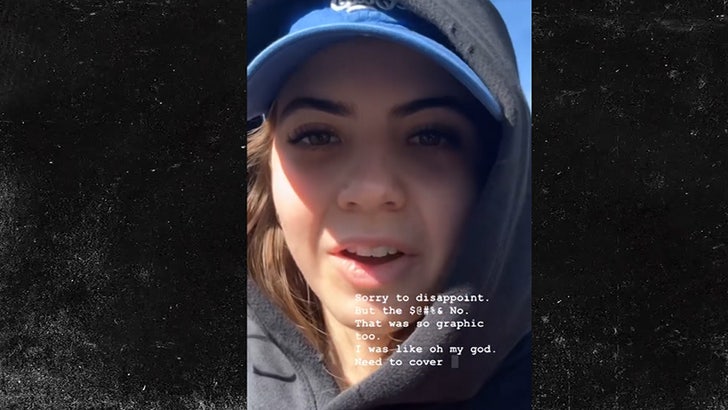The Truth Behind The 'Bobbi Althoff Leaked Video' And The Rising Threat Of AI Deepfakes
In the fast-paced world of online content, where virality can strike at any moment, podcaster and interviewer Bobbi Althoff recently found herself at the center of a disturbing digital storm. A purportedly leaked video, explicitly featuring her, began circulating online, sending shockwaves across social media platforms like X (formerly Twitter) and Reddit. However, as the dust began to settle, a crucial truth emerged: this video was not real. It was an AI-generated deepfake, serving as a stark reminder of the modern-day dangers posed by artificial intelligence.
The Viral Deception: What Happened?
The incident unfolded rapidly, as is often the case with sensational online content. A viral AI-generated video, provocatively titled "Bobbi Althoff leak video," began to spread like wildfire. This video showed an individual, whose likeness was superimposed with Bobbi Althoff's, performing an explicit act. The content was unequivocally X-rated and NSFW (Not Safe For Work), designed to shock and grab attention.
The video quickly gathered intense reactions from users across various platforms. On X, in particular, the content became a trending topic, with many users sharing it, often accompanied by warnings to others. The speed at which it disseminated highlighted the perilous ease with which harmful, fabricated content can permeate the digital sphere. It wasn't long before "Bobbi Althoff" was trending for all the wrong reasons, caught in a swirling vortex of misinformation and digital exploitation.
The Nature of the Deepfake
For those unfamiliar, a deepfake is a portmanteau of "deep learning" and "fake." It refers to synthetic media in which a person in an existing image or video is replaced with someone else's likeness. These sophisticated fakes are created using powerful AI algorithms that can learn and replicate facial expressions, body movements, and even voices, making them incredibly difficult to distinguish from genuine content, especially to the untrained eye.
In Bobbi Althoff's case, the deepfake video superimposed what appeared to be the 26-year-old's face onto another individual's body, creating a convincing yet entirely fabricated scenario. This level of manipulation underscores the advanced capabilities of current AI technology and the ethical quandaries it presents.
Bobbi Althoff Breaks Her Silence: A Clear Denial
As the "inappropriate" AI-generated video continued to trend and trigger widespread discussion, Bobbi Althoff, known for her "Really Good Podcast" and her unique interviewing style, wasted no time in addressing the situation directly. Taking to her Instagram Story on Wednesday, and later sharing a lengthy video, she broke her silence, unequivocally calling out the video as fake.
Her response was clear, concise, and tinged with a sense of exasperation at having to debunk such a malicious fabrication. "Hate to disappoint you all, but the reason I'm trending is..." she began, before clarifying that the sexually explicit video making the rounds on social media was not of her. She firmly stated, "The reason I’m trending is... not because I leaked anything. It's because of AI deepfakes." Her directness aimed to clear the air and dispel any lingering doubts about the authenticity of the content.
Althoff's quick and public denial was crucial in controlling the narrative. By immediately addressing the alleged deepfake images and video, she took agency over a situation that could have spiraled into prolonged reputational damage. Her message was a powerful one: this was a fabrication, a product of malicious intent and advanced AI.
The Deepfake Epidemic: A Modern-Day Threat
Bobbi Althoff's unfortunate experience is not an isolated incident. She has become the latest in a growing list of celebrities and public figures to be targeted by AI deepfakes. Just recently, pop superstar Taylor Swift faced a similar ordeal when sexually explicit AI-generated images of her went viral, sparking widespread outrage and calls for stronger protections against such digital abuse.
The rise of deepfake technology represents a significant challenge in the digital age. It blurs the lines between reality and fabrication, making it increasingly difficult for the average person to discern truth from deception. This technology can be used for a variety of harmful purposes, including:
- Reputational Damage: Creating false narratives or explicit content to harm an individual's public image.
- Harassment and Blackmail: Fabricating compromising situations to extort or harass victims.
- Misinformation and Disinformation: Spreading fake news or propaganda, potentially influencing public opinion or political outcomes.
- Erosion of Trust: Undermining public trust in media, news, and even visual evidence.
The case of Bobbi Althoff further highlights these dangers. It demonstrates how easily a person's image can be weaponized, causing emotional distress, reputational harm, and forcing victims to publicly defend themselves against fabricated content. The speed of viral spread only amplifies the damage, making it a race against time for victims to respond and for platforms to act.
Navigating the Digital Wild West: What You Can Do
In an era where AI can conjure convincing fakes with alarming ease, digital literacy and critical thinking are more important than ever. For the general public, understanding the risks and knowing how to respond is vital.
For Internet Users:
- Be Skeptical: If a video or image seems too sensational, too good (or bad) to be true, it likely is. Always approach viral content with a healthy dose of skepticism.
- Verify Sources: Check if the content is being reported by credible news outlets or if the person depicted has addressed it. In Bobbi Althoff's case, her direct statement on Instagram was the definitive source.
- Look for Inconsistencies: While deepfakes are advanced, subtle tells can sometimes exist, such as unnatural blinking, strange facial movements, or discrepancies in lighting and shadows.
- Do Not Share: Resist the urge to share unverified or potentially harmful content. Sharing deepfakes, even with good intentions (like warning others), can inadvertently contribute to their spread and further harm the victim.
- Report Harmful Content: If you encounter a deepfake or any other form of malicious content, report it to the platform it's hosted on (e.g., X, Reddit, Instagram). Platforms have policies against non-consensual explicit content and AI-generated misinformation.
For Platforms and Legislators:
The responsibility also lies with social media platforms and lawmakers. There's a growing call for:
- Enhanced Detection Tools: Developing more sophisticated AI to detect and flag deepfakes before they go viral.
- Faster Takedown Policies: Implementing swift and efficient processes for removing harmful deepfake content upon discovery or report.
- Legal Frameworks: Establishing clear laws that criminalize the creation and distribution of non-consensual deepfake pornography and other malicious AI-generated content, with severe penalties for perpetrators.
- User Education: Actively educating users about the dangers of deepfakes and how to identify them.
Conclusion: A Wake-Up Call for the Digital Age
The "Bobbi Althoff leak video" incident serves as a potent wake-up call regarding the escalating capabilities and misuse of artificial intelligence. What appeared to be a genuine, explicit video of the podcaster was, in fact, a meticulously crafted deepfake, designed to deceive and exploit. Bobbi Althoff's swift and unequivocal denial on Instagram was crucial in debunking the fabrication, but her experience underscores a broader, more insidious threat.
As AI technology continues to advance, the line between reality and simulation will only become blurrier. Incidents like this highlight the urgent need for increased digital literacy, robust platform safeguards, and stronger legal protections to combat the spread of malicious deepfakes. It's a collective responsibility to foster a digital environment where truth can prevail over fabrication, and where individuals like Bobbi Althoff are protected from the harmful consequences of AI misuse. The viral spread of the "Bobbi Althoff leak video," and her subsequent response, truly exemplify the modern-day dangers of artificial intelligence and the critical importance of discerning what's real from what's merely a sophisticated digital illusion.
What Is The Leaked Bobbi Althoff Video Going Viral On Social Media? The

Bobbi Althoff's Leaked AI Deepfake Video Was Likely Made This Way

Bobbi Althoff Reacts to 'Leaked' NSFW Video, Speaks Out After Going